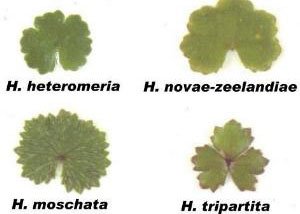Hydrocotyle (Hydrocotyle spp.)
Hydrocotyle, often called pennywort or lawn hydrocotyle, is a creeping perennial weed that thrives in damp, shady lawns across New Zealand. It spreads quickly through stolons (creeping, rooting stems) that form dense mats and smother healthy grass.
Several species occur in New Zealand, including Hydrocotyle moschata (hairy hydrocotyle), H. heteromeria (shiny-leaved hydrocotyle or waxweed), H. novae-zeelandiae, and H. tripartita (Australian hydrocotyle). While their appearance can vary slightly, they all behave the same way — aggressive, low-growing, and hard to kill.
Hydrocotyle is especially common in lawns with poor drainage, heavy shade, or overwatering. It’s also found in low-lying paddocks and overgrazed pastures, where it forms thick groundcover that excludes other plants.
Identification
Hydrocotyle forms small, round leaves on thin stems that root at every node. Each leaf is about 1 cm across, though size varies depending on mowing height and soil moisture. The leaves resemble tiny lily pads, each attached to its stem in the centre rather than at the edge like clover.
You can sometimes identify different species by leaf traits:
H. moschata – distinctly hairy leaves
H. heteromeria – smooth, shiny leaves (sometimes called waxweed)
H. tripartita – leaves divided into three small lobes, a bit like a miniature buttercup
H. novae-zeelandiae – usually plain round leaves, often with a faint reddish edge

The weed produces small clusters of green to brown fruiting bodies that sit close to the ground. Its stolons form a tight network that helps it recover quickly after mowing or partial herbicide control.
Why It’s a Problem in Lawns
Hydrocotyle spreads aggressively in wet or shaded areas, creeping under grass and rooting as it goes. It creates patchy, uneven turf that can be slippery when wet and very difficult to mow evenly.
Because it’s highly tolerant of most selective turf herbicides, it often survives normal broadleaf weed sprays that kill clover and dandelion. Once established, it tends to reappear each year unless the growing conditions are fixed.
Control in Home Lawns
Hydrocotyle is one of the toughest lawn weeds to remove, but it can be managed with persistence and the right approach.
Best control methods:
- Cultural control: Improve soil drainage, reduce irrigation, and thin surrounding trees or shrubs to let in more light. Hydrocotyle loves damp, shaded soil — fix that, and it’ll weaken naturally.
- Physical removal: Small patches can be dug out by hand, ensuring all stolons are removed.
- Chemical control: Use herbicides containing triclopyr (NZLA Gold) it provide stronger results but leave long-lasting residues — don’t compost clippings for several months.
- Timing: Spray when plants are actively growing, typically late spring to early autumn. Multiple treatments may be needed.
Prevention Tips
- Avoid overwatering shaded lawns.
- Aerate compacted areas to improve drainage.
- Fertilise in spring and autumn to encourage dense grass growth.
- Trim back hedges or shrubs to increase sunlight.
- Overseed after treatment to fill gaps and stop stolons re-rooting.